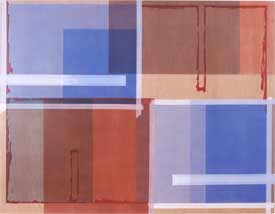Luciano Figueiredo
dal 9/7/2004 al 7/8/2004
Segnalato da
9/7/2004
Luciano Figueiredo
Lurixs Arte Contemporanea, Rio de Janeiro
The work of Figueiredo is clearly affiliated with constructivism and its lofty graphic tradition. This personal choice occurred more than three decades ago when the artist established an empathy with the formal investigations of the literature of Joyce, Pound and, consequently, with concrete poetry.

'Dioramas e Moucharabiehs'
Constructive Persistence
The chief cult icons of Brazilian culture are laden with affections, intense feelings and with a praise of immediacy – in short, emotion and a certain unboundedness would reign supreme in the tropics. In art, this version came out well synthesized, at times with keen irony, in certain works of the so-called ‘Generation 80’ – now celebrating the twentieth anniversary of their inaugural show. Against the grain, since the 1950s of the last century and under the aegis of constructivist theses, another version of Brazilian culture has evolved, one whose density, accumulated over the last five decades, is unquestionable. In it, reason dominates the process of poetic production and arouses an eulogy of the project as opposed to the empire of emotional facture. In order not to fall into a simplistic and convenient dualism, it is necessary to conduct an analysis of the complex connections that have developed between the two lines, when the works get emancipated from the purely cultural plane to attain the indisputable statute of artworks. Moreover, the poetic intelligence of the topmost expressions of Brazilian folk culture and show business contradict this unsubstantial image. On the contrary, whether knowingly or not, they are heading more to a constructive direction than towards a neo-romantic shopping-mall-style figurative art.
The work of Luciano Figueiredo is clearly affiliated with constructivism and its lofty graphic tradition. This personal choice occurred more than three decades ago when the artist established an empathy with the formal investigations of the literature of Joyce, Pound and, consequently, with concrete poetry. At the same time, the artist initiates his graphic researches while a London resident in the 70s. The graphic blotch of the newspaper page – the families of fonts and writings spelled out in different alphabets and ideograms printed in various languages – exerts an aesthetic appeal upon Luciano Figueiredo, something that the artist will exploit in diverse ways. It is worth mentioning that this formal option of artistic investigation takes place in parallel with the prevailing trends of the times – conceptual art, land art, body art and others – forcing the artist into a sort of generational backward movement due to his identification with the strictly constructive paradigms of a visual grammar whose boundaries were being continually exploited in Brazil for more than twenty years. This is an authentic elective affinity and not some hasty updating via the fashionable.
There are painters who still use nude bodies, mountains, or trees as their models; there is nothing more legitimate than this, moreover when, behind the palette and the paintbrushes, there exists a sensitive intelligence capable of reinventing those bodies and landscapes. Perhaps, owing to this, it is customary to think that the constructive painter turns his back to the world and uses exclusively the platonic entities of Euclidian geometry as his models. The purity of the geometric shape is surely a value to be taken into consideration when reason conducts the process of poetic production, but it is a misapprehension to think that the constructive artist, in his movement of abstraction, does not interact with the world and does not employ it as his model. The paintings by Luciano Figueiredo demonstrate this capacity of seeing the world, of grasping images of daily life and transforming them into the poetic operation of decanting its more saturated elements to give them back to our eyes arranged in a new order of planes and colors. His first models were newspaper pages and nothing is more ubiquitous in urban life than these icons of printed information. From the graphic saturation of the page covered by typography to the cleanliness of the blank sheet it was just one more step.
Luciano Figueiredo’s starting point is a graphic thought to which a painterly knowledge will be added in a non-violent way, but the latter does not obscure the former. The painting does not rush over the graphic orderliness, it is superimposed onto it with a clever use of transparency. Thus, two universes may live together in one sole world of close collaboration, with no greater tensions or conflicts. Recently, the layers of paint have been spreading out liquidly, but with no exaggeration and no penchant for the spectacular – they just exert, due to the action of gravity, their spreading out upon the superimposed layers without inhibiting the previous order. Not even the support is entirely masked by the painter: the wood, its texture and its organic origin, they all come through as elements of the work with a formal presence that bears the same statute of the pictorial layers. The same thing occurs with the newspaper pages, for they do not compete with nor vehemently lessen the construction – it is about plastic interaction. The absence of clashing chromatic oppositions and this universe of a non-forced balance (after all, there are encounters and un-encounters, shapes that descend while others ascend) – it all refers to a world that does not yet exist, but nothing prevents it from coming into being, in an optimistic calculation of probabilities, which is nothing short of a statistic that defies reason. A world with no dramas or tensions, where the existing conflicts are strictly those that are necessary to establish the relations of the individuals that inhabit it: for now, just the memory of rectangles and squares that once were newspaper pages.
Paulo Sergio Duarte
Rio de Janeiro, June 2004.
Translated by Paulo Andrade Lemos
Rio de Janeiro, June 2004.
Exhibition hours
Mon - Fri 2 pm - 7 pm
Sat 4:30 pm - 8 pm
Lurixs
Rua Paulo Barreto 77, Botafogo
Rio de Janeiro



